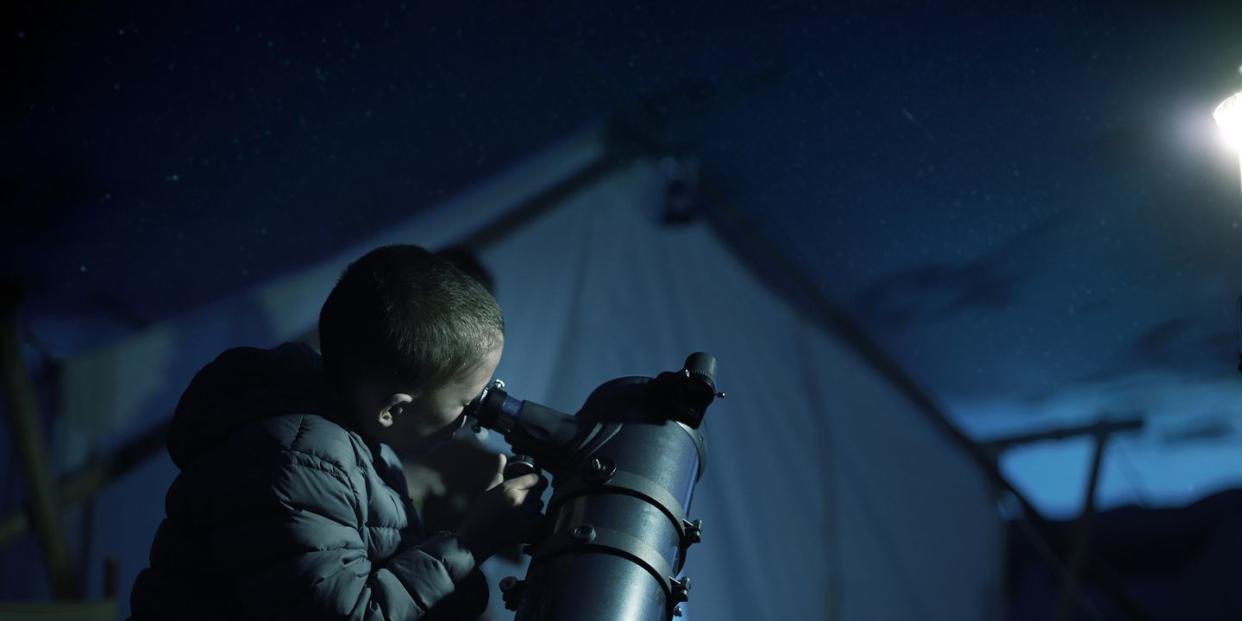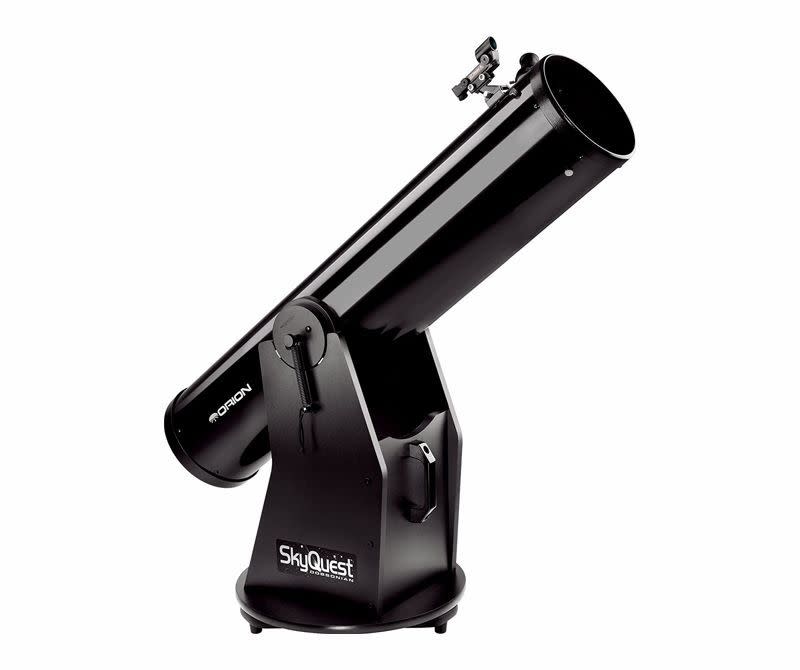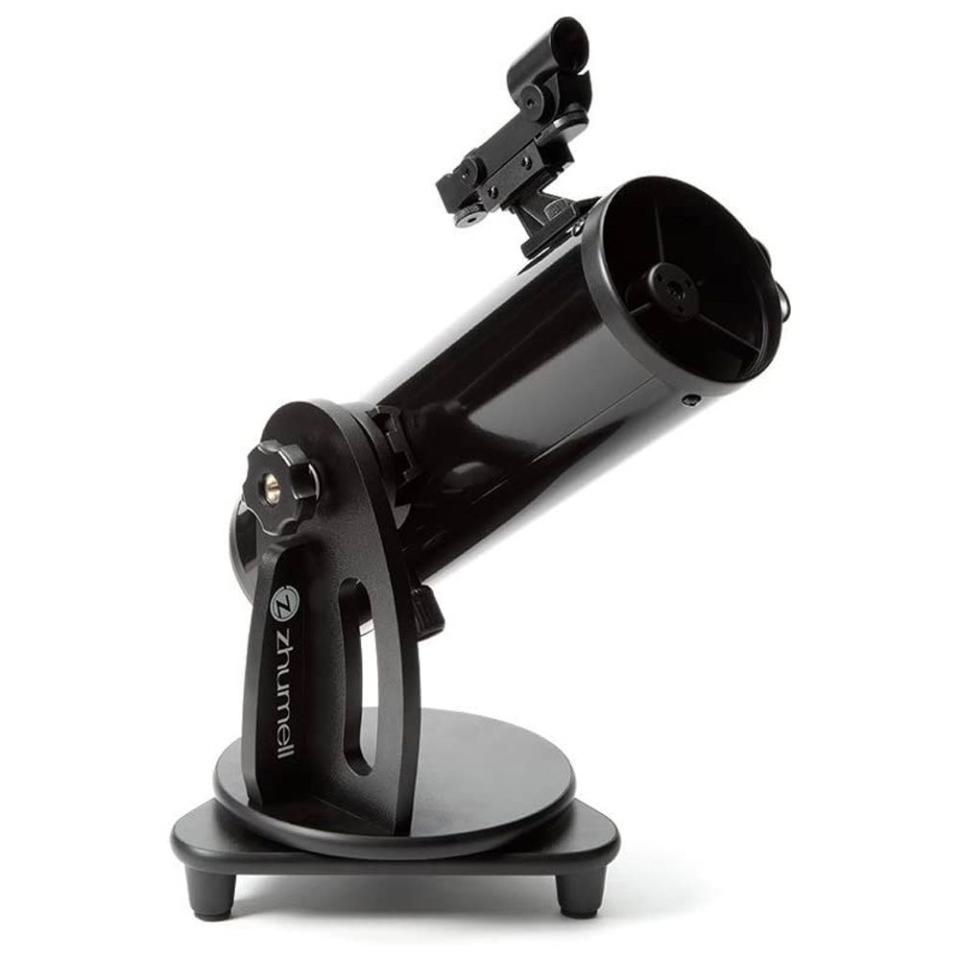The Best Telescopes For Observing Our Solar System and Beyond

"Hearst Magazines and Yahoo may earn commission or revenue on some items through these links."
When folks think of what they love about summer, they tend to focus on what they can do in the sun – picnics, swimming at the beach, lemonade stands. After all that daytime fun, though, there are lots of great things to do on summer nights after the Sun goes down. Warm summer nights are the perfect time to try out a new telescope to see the stars, planets and galactic features of the summer night sky!
If you are looking forward to experiencing these skies for yourself, a telescope is a phenomenal gift for a loved one (or yourself). We’ll teach you about the basics of telescopes, including how to pick one that will help you build memories and experiences that could last a lifetime.
Best Telescopes
Best Overall: Celestron NexStar 8 SE Computerized Telescope
Best Value: Orion Skyquest XT8
Best For Beginners: Zhumell Z100 Altazimuth Reflector Telescope
Wide Aperture: Apertura 10-Inch Dobsonian Telescope
Best for Astrophotography: William Optics RedCat 71 f/4.9 APO Astrograph Refractor
The Expert I’m a lifelong space enthusiast who delights in sharing our connection to astronomy in both my personal and professional life. By day, I work as a public affairs specialist for NASA, representing the agency at events like air shows and conventions. In my spare time, I also teach classes on stargazing under urban skies in the Bay Area to help share astronomy with everyone, everywhere.
Start With Binoculars
In fact, what many astronomers advise is to not start out with a telescope at all, but with a good pair of binoculars. They’ll not only give you a great view of the lunar surface, but let you see things like Saturn’s oblong shape (due to its rings) and Jupiter and its moons—as well as distant galaxies and closer nebulae. Even if your interest in astronomy wanes, you’ll still be able to use binoculars for things like birding, baseball games, and other outdoor activities.
For backyard astronomy, most experts recommend a 7 x 50 or 10 x 50 set of binoculars—or, as Ed Ting of Scopereviews.com notes,“ the largest lenses you can comfortably hold.” It’s the second number in that equation, the aperture of the lens (measured in millimeters), that’s the most important consideration.
If you’re familiar with photography at all, you’ll know that’s what determines the amount of light the lens gathers. This makes a bigger difference in what you can see than the magnification factor, which is the first number of those two.
For the upper weight class of binoculars like the Celestron Skymaster pair, you’ll want to consider a tripod. A standard camera tripod will work, but consider splurging on the height-adjustable and true-pointing tripod add-on known as the Paragon Plus.
Not only will it take the weight of your binoculars out of the question, it will allow you to lower or raise the optics so that a family member or friend can share in the view without losing your target object.
As with many hobbies, it’s also a good idea to connect locally and join an astronomy club in your area. That way, you can learn some of the basics from experts and try out different types of telescopes before taking the plunge on one yourself. Sky & Telescope has an extensive directory of local clubs.
More Gear for Stargazers: Best Star Projectors ● Best Space-Themed Gifts ● Best Stargazing Apps
What to Consider While Shopping For a Telescope
There is no one universally perfect telescope. An ultra-high power astrophotography setup would be useless to someone who simply wants to get a closer look at the Moon. Even for hobbyists, there are many, many kinds of telescopes to choose from.
Picking the right one will ensure you get all the features you want, and that you have a good sense of how to get the most out of the one you buy. You don’t need to spend a fortune to get the best telescope for you.
[accordion id='0edcdee0-42d5-4116-bde1-a58e181fd472'][/accordion]
How We Selected These Telescopes
To pick the best telescopes, I relied on my personal experience as an avid stargazer and recommendations from expert users online and at local star parties. I also checked reviews from well-regarded community sites and observer forums, such as Cloudy Nights, as well as user reviews on retail sites, including High Point Scientific and Telescopes.com.
In addition to recommending specific models, I also suggest the best ways to use each telescope, so you can pick one based on how you plan to use it. Remember, the best telescope for you is the one you’ll get the most use out of - not always the biggest or most expensive.

NexStar 8 SE Computerized Telescope
$1599.00
amazon.com
The NexStar series is well-pedigreed in astronomical circles, and the distinctive orange tube is a common sight at star parties. The larger model, which features an 8-inch lens, strikes a great balance between power, price, and convenience. Despite its larger size, the NexStar 8 SE is still portable, thanks to its compact-but-complex design that replicates the optic performance of a longer telescope.
Its cost is certainly not cheap, but it’s more than worth it for the generous increase in light captured and the subsequent uptick in the quality of your observations. That the computerized pad and guidance have not changed much in the past decade is a sign of the high degree of reliability.
The NexStar works very well, and with a bit of practice, a new user can get it pointing and tracking with a decent degree of precision. As with any computerized telescope, a power source will be required, either from an outlet or portable power pack.

SkyQuest XT8
649.99
amazon.com
The SkyQuest is a telescope near and dear to my heart. For less than $1,000, it features a large 8-inch light collecting area with great observation quality, unlocking farther and fainter objects for the observer than the average starter telescope. The downsides are weight (it’s about 40 pounds) and size (the tube alone is 46 inches), so this isn’t a great telescope for carrying up a mountain or storing in a small apartment.
If you have the room, it does a great job for stargazing when car camping, however. Under a dark sky, the XT8 can reveal nebulae, Saturn’s rings, the moons of several planets—pretty much anything you can and will want to point it at. Without an onboard computer, you will be handling the aiming and tracking, but don’t panic. There is no better way to learn the night sky than with a simple and forgiving telescope like this one, along with a digital or analog star map.

Z100 Altazimuth Reflector Telescope
$159.99
amazon.com
I have watched the “mini-dob” (miniature Dobsonian mount telescopes, not a new dog breed) market with fascination. All too often, I’ve heard of families buying a “value” telescope only to discard it in frustration because it was difficult to use and didn’t show the sky clearly. This is a solution to all those challenges in a grab-and-go mini package.
The 4-inch lens in the Z100 isn’t huge, but it’s large enough to spot planets and more subtle lunar features. The self-contained design makes it easy to tote around and eliminates the need for setup or takedown. Keep in mind it works best sitting on a picnic or camp table.
If you are opposed to sitting on the ground or are less flexible, this will be an inconvenience. However, this no-fuss design is ideal for those who don’t want the hassle of setting up a bigger ’scope, or for a new observer who wants to learn the sky.

10-Inch Dobsonian Telescope
$949.95
telescopesplus.com
You may have guessed, I have a big spot in my heart for big ol’ Dobsonian telescopes. This Apertura has a 10-inch aperture, which is about as large a lens as you can hope to get on a hobby-grade telescope. It can show you some of the really hard-to-find sights of our Solar System that you won’t be able to check out with something smaller and/or less expensive.
You can see the gap in Saturn’s rings, variation on the surface of Mars, and even the clouds of Jupiter (if the time and conditions are right). You’ll also be able to see lots of “deep sky” objects, like galactic and nebula features, as well as extragalactic objects. (Again, under a very dark sky).
The Apertura isn’t especially portable, so the Dobsonian design is a limiting factor. If you go car camping or are willing to haul this big-ol-thing someplace truly dark, though, it’ll absolutely flip your lid.

RedCat 71 f/4.9 APO Astrograph Refractor
$1698.00
highpointscientific.com
If you want to take pictures of the night sky, rather than simply observe, you need a specialized astrographic telescope, also called an astrograph. Hobby-grade astrographs, like the William Optics RedCat 71, attach to a DSLR camera in lieu of a standard lens, giving you the ability to take clear pictures of what you’d normally see through a telescope. (Depending on your camera, you may need an adapter. I recommend Apertura’s rings for Canon and Nikon.)
Amateur astronomers swear by the RedCat series. It features a four-lens refractor–most astrographs have two lenses–which creates sharp focus for the whole field-of-view, without blurring around the edges. The RedCat comes in many sizes, but I recommend the largest aperture available, 71mm.
With a camera attached, even a modest telescope can collect a large amount of light to enable you to see faint objects. Unfortunately, that means it is especially susceptible to light pollution, so you’ll want to take it somewhere extra dark to get great shots.

40mm f/10 B500 Dedicated H-alpha Solar Telescope
$749.00
highpointscientific.com
If you plan to observe the upcoming eclipses in 2023 and 2024 (and you want to save your vision), you will need some specialized equipment. Yes, true, you can make a cereal box pinhole projector or look through a colander like every other Tom, Dick, and Harry on the block, but there’s a much tastier visual feast to check out if you pick up a solar telescope, which is designed specifically to let you observe a solar eclipse and related phenomena.
If you’re ready to give solar astronomy a shot, we love Lunt’s 40mm solar telescope, which has built-in filters that allow you to see “H-alpha light” coming in around 0.65 angstroms - a deep red. This color of light is produced just outside the photosphere of the Sun, where the light we see is produced. By limiting ourselves to this specific color, we can see that outer “invisible” layer.
Since most of us will have to travel to see the eclipse, it also helps that this one weighs less than 3 pounds. Attach it to another ‘scope (maybe one with a neutral filter on the front) and get to viewing!
Our Expert M. Josh Roberts Answers Your Most Common Telescope Questions
[accordion id= 'e879ba67-dba3-456f-b2d1-ba8047726d55'][/accordion]
*Editor's Note: Don Melanson contributed to this article.
You Might Also Like

